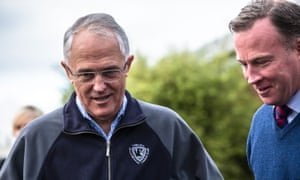The prime minister, Malcolm Turnbull,
has revealed proposals currently before the Australian Renewable Energy
Agency to expand Tasmania’s hydro power industry and add some 2,500MW
in pumped hydro storage to the grid.
Arena will work with Hydro Tasmania, the state-owned generator, on a feasibility study on the proposals.
The Tasmanian premier, Will Hodgman, told reporters at a meeting with the prime minister in Launceston that if the plan goes ahead it would make the state “the renewable energy battery of the nation”.
Hodgman said it had long been his vision to cement Tasmania’s place as the renewable energy storage centre of the nation.
Hydro Tasmania’s chief executive, Steve Davy, said the company had “nation-leading expertise in integrating renewable energy into the grid in a stable and affordable way”.
“We’ve done that innovatively and successfully in Tasmania, and it’s
the very challenge mainland Australia is starting to grapple with,” he
said.
Arena will look at how to increase the energy output from Tasmania’s hydro power system and also 13 potential new pumped hydro storage projects, which could more than double the system’s capacity. The agency will put $2.5m towards the cost of the study.
It is already doing a feasibility study on a $2bn expansion of the Snowy Hydro scheme in New South Wales to boost energy storage in the national electricity grid.
“We recognise as the energy system changes, you need the ability to back that up – to store it or to provide the backup power with gas,” Turnbull said. “The energy market is progressing, the evolution of it is very rapid, so I think the sooner we can see the opportunities here in Tasmania the better.”
A study looking at the possibility of adding a second Basslink cable between the island and the mainland was also released on Thursday.
The existing Basslink cable was severed in December 2015 and remained out of service for six months, causing power shortages in the state due to it coinciding with a lack of rainfall and shortages in hydropower.
The study, chaired by John Tamblyn, a former chairman of the Australian Energy Market Commission, found a second cable could be of benefit but it would depend on growth in the state energy system and the National Energy Market.
• Australian Associated Press contributed to this report
Arena will work with Hydro Tasmania, the state-owned generator, on a feasibility study on the proposals.
The Tasmanian premier, Will Hodgman, told reporters at a meeting with the prime minister in Launceston that if the plan goes ahead it would make the state “the renewable energy battery of the nation”.
Hodgman said it had long been his vision to cement Tasmania’s place as the renewable energy storage centre of the nation.
Hydro Tasmania’s chief executive, Steve Davy, said the company had “nation-leading expertise in integrating renewable energy into the grid in a stable and affordable way”.
Arena will look at how to increase the energy output from Tasmania’s hydro power system and also 13 potential new pumped hydro storage projects, which could more than double the system’s capacity. The agency will put $2.5m towards the cost of the study.
It is already doing a feasibility study on a $2bn expansion of the Snowy Hydro scheme in New South Wales to boost energy storage in the national electricity grid.
“We recognise as the energy system changes, you need the ability to back that up – to store it or to provide the backup power with gas,” Turnbull said. “The energy market is progressing, the evolution of it is very rapid, so I think the sooner we can see the opportunities here in Tasmania the better.”
A study looking at the possibility of adding a second Basslink cable between the island and the mainland was also released on Thursday.
The existing Basslink cable was severed in December 2015 and remained out of service for six months, causing power shortages in the state due to it coinciding with a lack of rainfall and shortages in hydropower.
The study, chaired by John Tamblyn, a former chairman of the Australian Energy Market Commission, found a second cable could be of benefit but it would depend on growth in the state energy system and the National Energy Market.
• Australian Associated Press contributed to this report

No comments:
Post a Comment